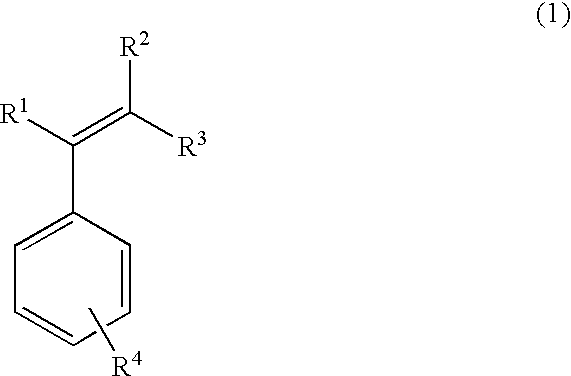Toner for developing electrostatic latent image
a technology for developing latent images and toners, applied in the field of toners for developing electrostatic latent images, can solve the problems of reducing the heat resistance of toners during storage, adversely affecting the chargeability of replenished toners, and unable to quickly charge to a specific charge amount, etc., to achieve excellent fixing characteristics and reduce the amount of applied release oil
- Summary
- Abstract
- Description
- Claims
- Application Information
AI Technical Summary
Benefits of technology
Problems solved by technology
Method used
Image
Examples
example 1
Toner Y1
[0105] The binder resin A3 and pigment master batch were used in the amounts of 100 pbw binder resin A3 and 7.0 pbw C.I. pigment yellow 180, to which was added 5 pbw polymer B2, 5 pbw oxided polyethylene wax (Sanwax E250P; Sanyo Chemical Industries, Ltd.; softening point 103.5.degree. C.; acid value 19.5 KOHmg / g), and 3 pbw oxided polypropylene wax (Biscol 110TS; Sanyo Chemical Industries, Ltd.; softening point 140.degree. C.; acid value 3.5 KOHmg / g), and after the material was mixed for 5 min in a Henschel mixer at a speed of 40 m / s and the specimen temperature was controlled so as to not surpass 45.degree. C. or higher, the material was subjected to high temperature fusion kneading at a maximum temperature of 200.degree. C. using the a two-shaft extrusion kneader (model PCM-30; Ikegai Tekko K.K.) from which the discharge unit had been removed. The pass-through time of the processed material was approximately 1 min. The obtained kneaded material was rolled 2 mm by a cooled ...
examples 2 , 3
Examples 2, 3
Toner C1, M1
[0106] Toner C1 and M1 were obtain by the same method as in example 1 with the exception that the pigment master batch was changed, and the binder resin A3 and pigment master batches used were 100 pbw binder resin A3 and 5.0 pbw C.I. pigment blue 15-3, and 100 pbw binder resin A3 and 4.5 pbw C.I. pigment red 184.
example 4
Reference Examples 1 to 3
Toners C2 to C5
[0107] Toners C2 to C5 were obtained by the same method as used in example 2 with the exception that the polymer B2 was replaced by polymers B1, B3 to B5, respectively.
PUM
| Property | Measurement | Unit |
|---|---|---|
| softening point | aaaaa | aaaaa |
| glass transition point | aaaaa | aaaaa |
| softening point | aaaaa | aaaaa |
Abstract
Description
Claims
Application Information
 Login to View More
Login to View More - R&D
- Intellectual Property
- Life Sciences
- Materials
- Tech Scout
- Unparalleled Data Quality
- Higher Quality Content
- 60% Fewer Hallucinations
Browse by: Latest US Patents, China's latest patents, Technical Efficacy Thesaurus, Application Domain, Technology Topic, Popular Technical Reports.
© 2025 PatSnap. All rights reserved.Legal|Privacy policy|Modern Slavery Act Transparency Statement|Sitemap|About US| Contact US: help@patsnap.com

